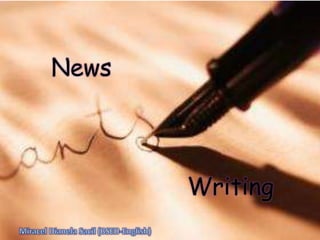
News writing presentation
- 1. News Writing
- 3. A report of recent events A material reported in a newspaper or news periodical or on a newscast A matter that is news worthy Dictionary defines news as;
- 4. Reporters and editors must think about their readers as this will help them decide what stories are newsworthy.
- 5. They should be guided by questions like: • What is the news here? • Why should my readers care? • What does this mean to them? • What questions will the reader have that I need to answer?
- 6. Major types of stories found in newspaper and magazines are: 1. Soft news- a news story that can wait for publication and is usually about a trend, an on-going event or about an interesting person. 2. Feature- an in-depth, magazine-length story 3. Personality Profile- a story that explore a person in the news, or an interesting but not-so-prominent person 4. Backgrounder- a story providing additional information on a news event (often called “sidebars”, and it may accompany a longer news story).
- 7. News values -a criteria which enable to determine whether a story makes into news.
- 8. Common news values are: 1. Immediacy 2. Significance 3. Proximity or nearness 4. Prominence 5. Human interest 6. Negativity 7. Conflict 8. Oddity 9. Humor
- 9. - A news reporter is imbued many powers: to inform, to influence decisions, and to help shape public opinion, among others. News Qualities
- 10. Following are the qualities that a news story should have: 1. Accuracy 2. Clarity 3. Objectivity 4. Balance and fairness 5. Attribution 6. Style
- 11. -Journalist normally organize their news stories using the so-called inverted pyramid structure. Structure of a news story
- 12. The lead -the opening paragraph of a news story. It is typically a one-sentence paragraph that summarizes the basic facts of a story and conveys to the reader what the reporter found out in his/her reporting. It provides answer to the five Ws and one H of news reporting-who, what, where, when, why and how.
- 13. The angle -The main idea of a news story and lead is called the “angle”. It is the main point that the rest of the story will try to support.
- 14. Body of a story -The rest of the story is called the body. A story should proceed in a natural and chronological order. Sticking to a logical order will make it easier to write the story, as well as to allow you to keep track of your ideas and materials.
- 15. The Ending -wraps up the remaining details of the story. One way to end is with a “kicker”, which is often a catchy quote.
- 16. Writing the news story -all the work of crafting a news story is pointless if the story does not engage the reader immediately. Basic steps in writing the news story: 1. List all your facts. 2. Arrange your facts in a descending order, or form the most important (or most interesting) to the least important (or least interesting).
- 17. 3. Always put the news at the beginning (lead). Write the lead making sure to play up the most interesting or important points. 4. Write the next paragraph or paragraphs presenting the other highlights or answering the questions not answered. 5. Add other facts, keeping in mind their descending order of importance.
- 18. Pointers in writing the news Story 1. One idea per sentence-As much as possible, write one-idea, one-sentence Paragraphs. 2. Limit the sentence length to not more than 25 words-Simplify. The simplest and clearest way of saying something is often the shortest and most eloquent. 3. Follow the subject-verb-object format- Good news writing starts with good sentence structure, and that means simple construction: Subject-verb-object. Refrain from using a lot of commas.
- 19. 4. Use strong verbs and an active voice- write most of your sentences like this: “somebody does something”. Note also that when a sentence is recast into active voice, it becomes shorter. 5. Reduce difficult words to their simplest terms- as much as possible, use words that are understandable by the average reader. When it is necessary to use unfamiliar or technical terms, explain them briefly. Prefer concrete, specific words to abstract. General ones.
- 20. 6. Use no more than three prepositional phrases per sentence. 7. Choose the precise word. 8. Keep it simple- write to express not to impress. 9. Show, don’t tell- don’t just describe something. Reveal a piece of the world to yourself and to your readers. 10. Give your source when necessary- Those people and documents need to be cited in attribution because that helps the
- 21. the reader evaluate the reliability of information. 11. Identify all persons- write their full names the first time they are mentioned. 12. Keep it objective- stay completely impartial. Do not use “I” and “me” unless you are quoting someone. 13. Have an angle- it can help make the purpose of the story clear and give it focus. 14. Quote people. 15. Avoid preaching at the end of the story.
- 22. 16. Be very careful- choose your words with care. Do not assume their meaning. Use dictionary to make sure of word meanings. Watch your grammar, spelling, capitalization, punctuation, use of abbreviations and sentence construction. 17. Read newspaper everyday- study constantly the construction of news stories in good national newspaper to improve your writing style and technique.
- 23. Tips in news gathering 1. See for your self 2. Find the person who knows 3. Compare all versions 4. Get both sides 5. Do not give up too easily 6. Be tactful and courteous 7. Make and keep friends 8. Get into print 9. Research 10. Observe proper attribution.
